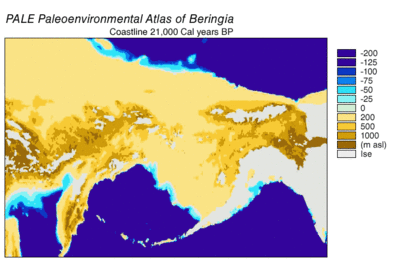| Beringian wolf | |
|---|---|

| |
| Two models of Beringian wolves created by paleo-artists working at the Yukon Beringia Interpretive Centre | |
| Scientific classification | |
| Domain: | Eukaryota |
| Kingdom: | Animalia |
| Phylum: | Chordata |
| Class: | Mammalia |
| Order: | Carnivora |
| Family: | Canidae |
| Genus: | Canis |
| Species: | C. lupus |
| Population: | †Beringian wolf |

The Beringian wolf is an extinct population of wolf (Canis lupus) that lived during the Ice Age. It inhabited what is now modern-day Alaska, Yukon, and northern British Columbia. Some of these wolves survived well into the Holocene. The Beringian wolf is an ecomorph of the gray wolf and has been comprehensively studied using a range of scientific techniques, yielding new information on their prey species and feeding behaviors. It has been determined that these wolves are morphologically distinct from modern North American wolves and genetically basal to most modern and extinct wolves. The Beringian wolf has not been assigned a subspecies classification and its relationship with the extinct European cave wolf (Canis lupus spelaeus) is not clear.
The Beringian wolf was similar in size to the modern Alaskan Interior wolf (Canis lupus pambasileus) and other Late Pleistocene gray wolves but more robust and with stronger jaws and teeth, a broader palate, and larger carnassial teeth relative to its skull size. In comparison with the Beringian wolf, the more southerly occurring dire wolf (Aenocyon dirus) was the same size but heavier and with a more robust skull and dentition. The unique adaptation of the skull and dentition of the Beringian wolf allowed it to produce relatively large bite forces, grapple with large struggling prey, and therefore made predation and scavenging on Pleistocene megafauna possible. The Beringian wolf preyed most often on horse and steppe bison, and also on caribou, mammoth, and woodland muskox.
At the close of the Ice Age, with the loss of cold and dry conditions and the extinction of much of its prey, the Beringian wolf became extinct. The extinction of its prey has been attributed to the impact of climate change, competition with other species, including humans, or a combination of both factors. Local genetic populations were replaced by others from within the same species or of the same genus. Of the North American wolves, only the ancestor of the modern North American gray wolf survived. The remains of ancient wolves with similar skulls and dentition have been found in western Beringia (northeastern Siberia). In 2016, a study showed that some of the wolves now living in remote corners of China and Mongolia share a common maternal ancestor with one 28,000-year-old eastern Beringian wolf specimen.